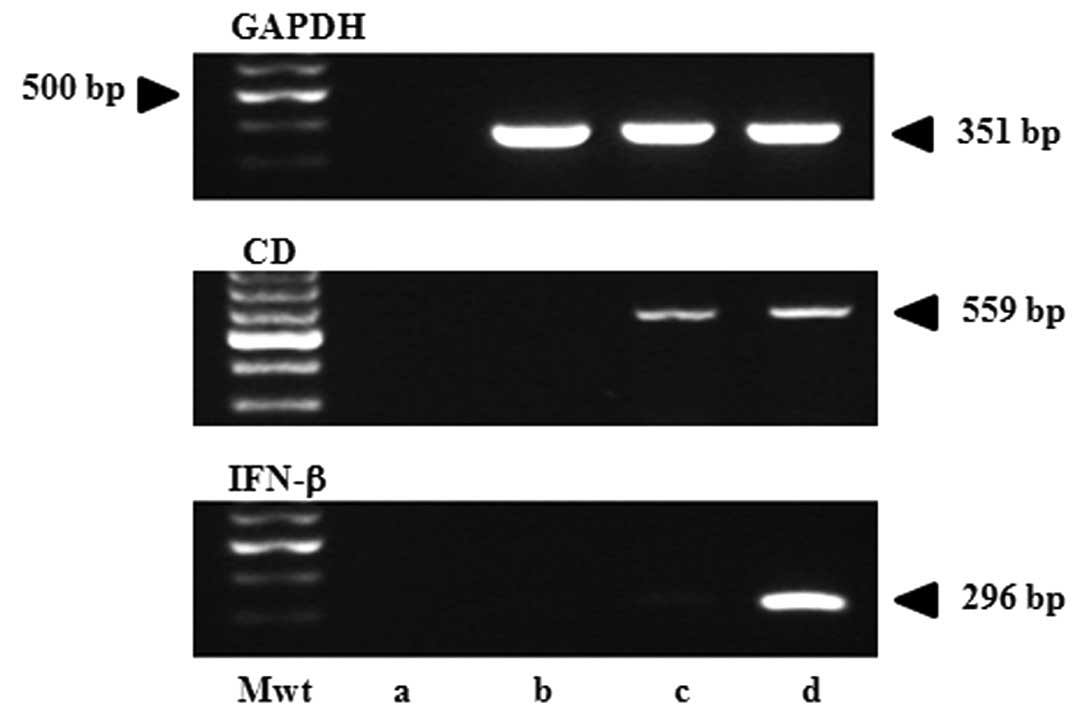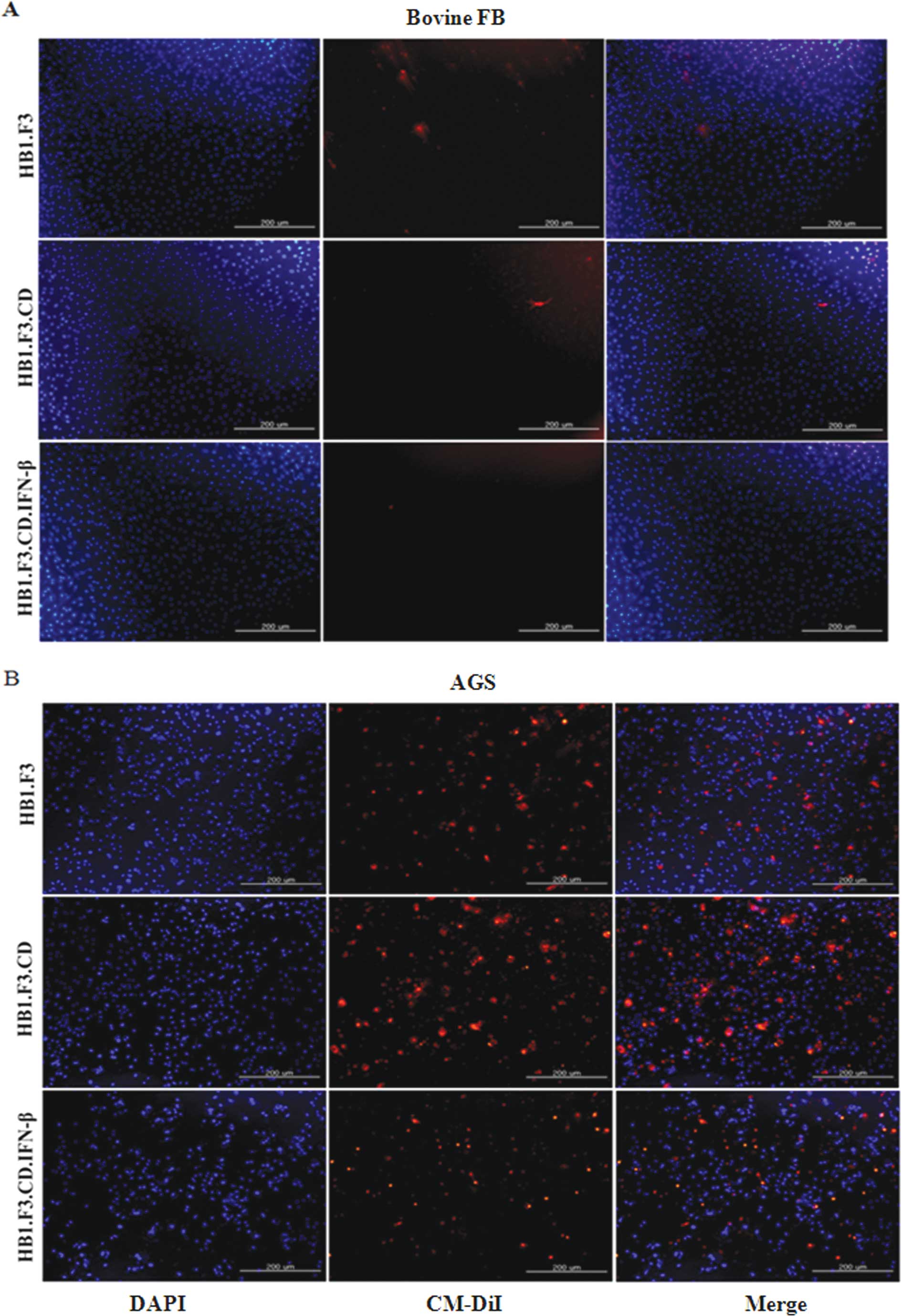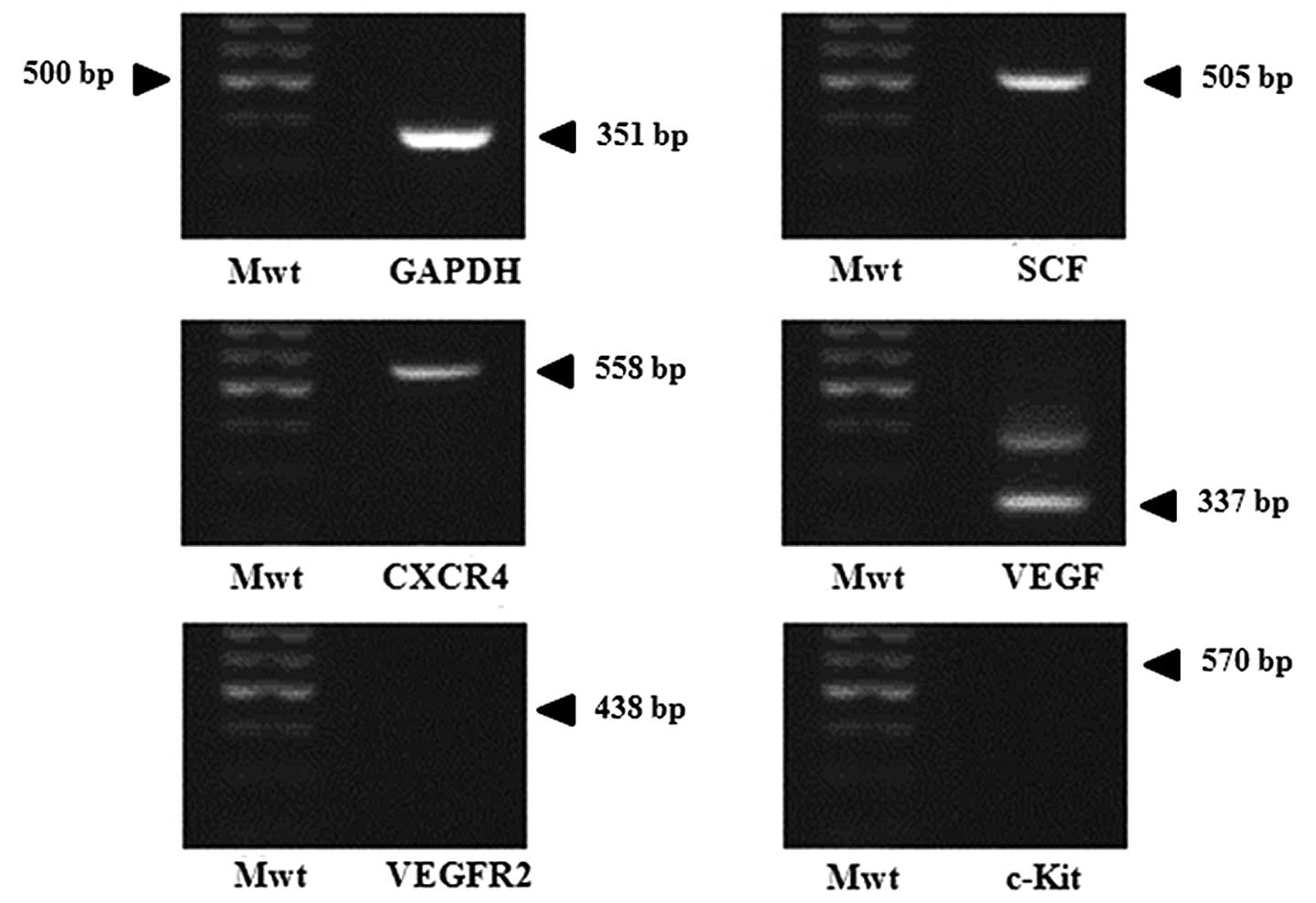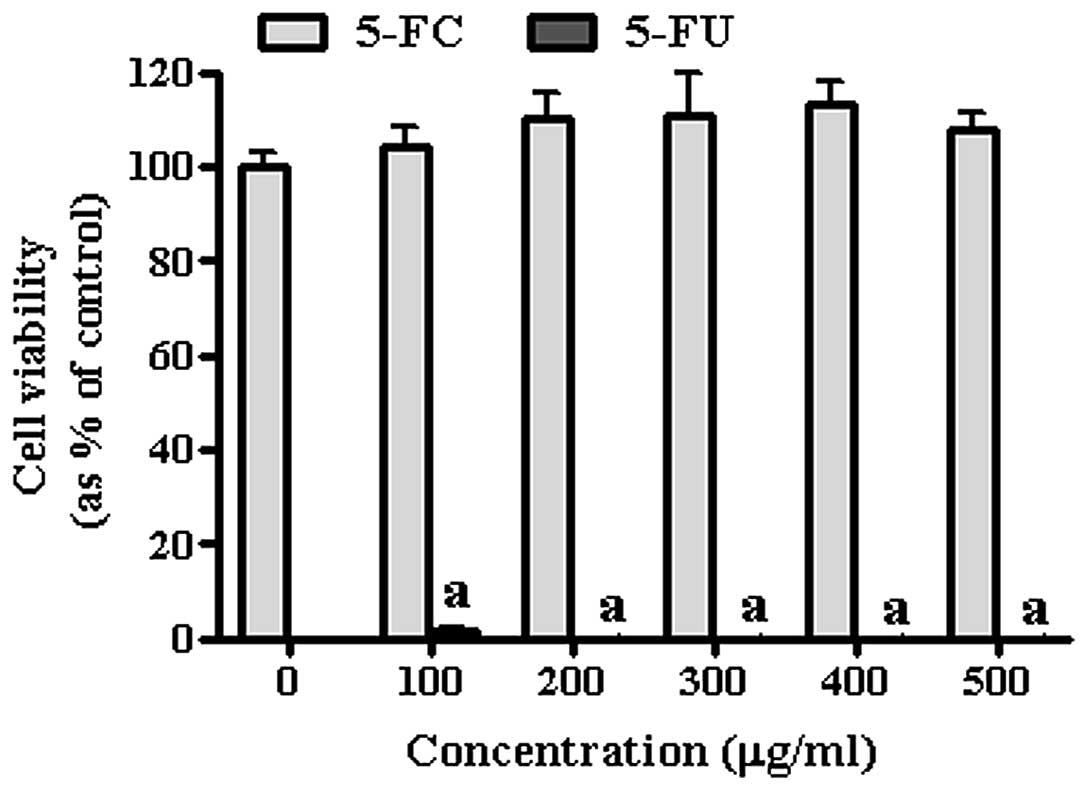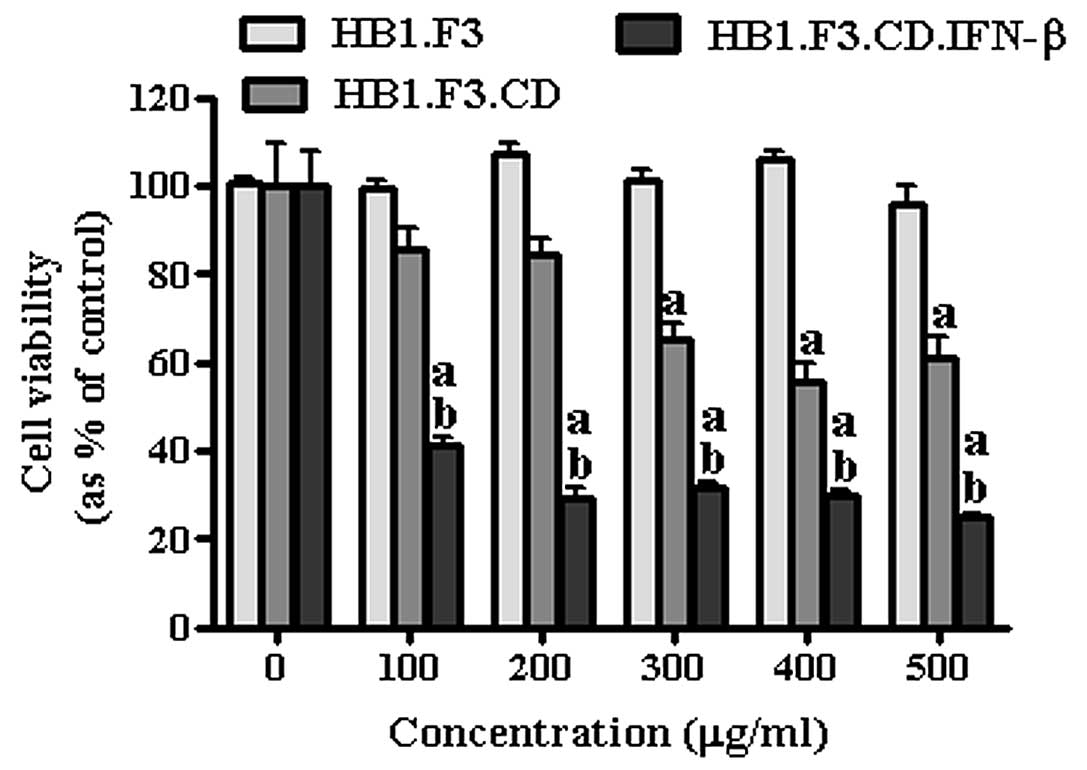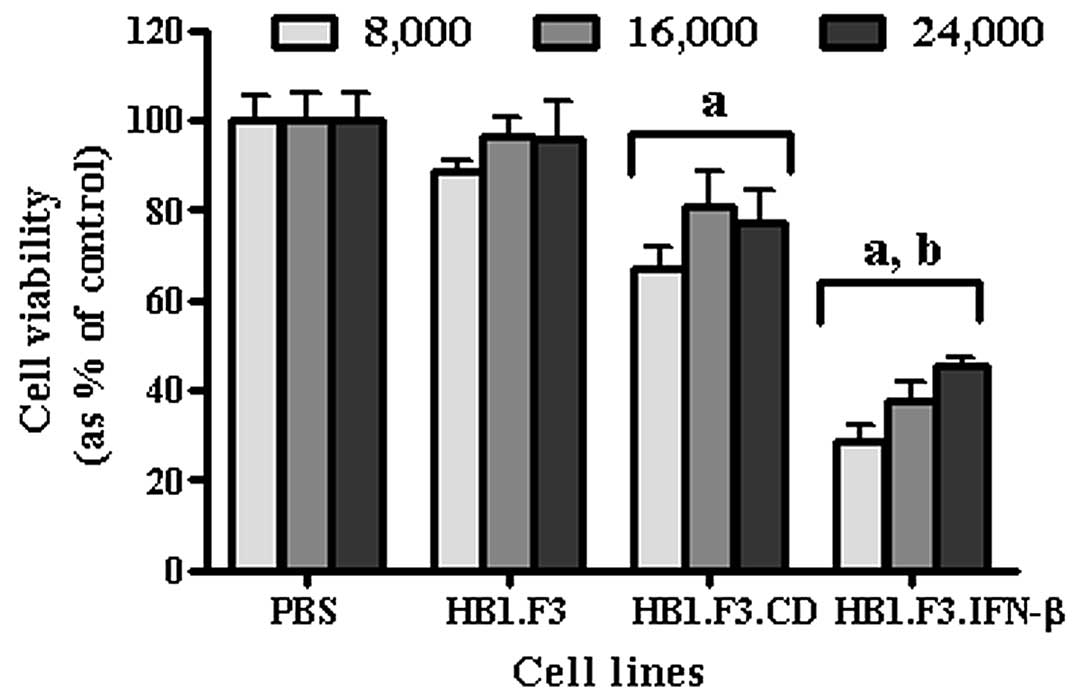Stem cells with fused gene expression of cytosine deaminase and interferon-β migrate to human gastric cancer cells and result in synergistic growth inhibition for potential therapeutic use
- Authors:
- Published online on: December 8, 2011 https://doi.org/10.3892/ijo.2011.1288
- Pages: 1097-1104
Abstract
Introduction
Gastric adenocarcinoma is major type of the gastric cancer (1) and in most cases, they are detected in advanced stages. Despite the development of various treatments (e.g., gastrectomy, chemotherapy, radiation therapy) gastric adenocarcinoma ranks second in deaths caused by cancer, although the incidence rate ranks fourth (2). Several drugs are being used in gastric cancer therapy including 5-fluorouracil (5-FU) or its analog capecitabine, BCNU (carmustine) as well as methyl-CCNU (semustine), doxorubicin (Adriamycin), mitomycin C, cisplatin and Taxotere (3,4). Although chemotherapy has been used for a long time, there is no clear standard of care and since gastric cancers are not particularly sensitive to these drugs, chemotherapy is mostly used to reduce the size of the tumor before surgery or used as adjuvant therapy (5). Since the selectivity of the drugs is low, treatments typically include systemic toxicity (3). To reduce these side effects, further studies are needed for safer and efficient treatment for gastric cancer (5–7).
Stem cells have recently become of great interest for researchers with the possibility of clinical use in cancer treatment. While traditional chemotherapy involves administration of manufactured drugs, genetically engineered stem cells (GESTECs) induces cells to produce the therapeutic agent (8,9). This technique enables one to replace damaged genes or insert additional genes with a new function. For example, human neural stem cells (hNSCs) are one of the candidate stem cells showing therapeutic potential and tumor tropism for the treatment of malignant tumors in the human brain including medulloblastomas and gliomas (10–12). This supports the possibility of using hNSCs as a gene carrier to the tumor site as well as a tumor-specific enzyme/pro-drug system with concomitant prodrug administration (13). HB1.F3 is an immortalized hNSC derived from human fetal brain at 15 weeks of gestation by an amphotropic, replication-incompetent retroviral vector v-myc (14,15). Clonal HB1.F3.CD cells were derived from parental HB1.F3 cells transfected with an Escherichia coli (E. coli) cytosine deaminase (CD) gene (14). Additionally, clonal HB1.F3.CD.IFN-β cells were derived from parental HB1.F3.CD cells and their cells express both E. coli CD and human interferon-β (IFN-β) genes (8). This clonally isolated, multi-potent hNSC has the ability to self-renew and to differentiate into cells of neuronal and glial lineages both in vivo and in vitro (14).
The CD/5-fluorocytosine (5-FC) system is a gene-directed enzyme/pro-drugs therapy (GEPT) (16–20) which converts the non-toxic prodrug 5-FC into the cytotoxic metabolite, 5-FU (21,22). 5-FU inhibits DNA synthesis in cells and results in cytotoxicity (23,24). This CD/5-FC GEPT system has been tested experimentally against several types of tumors including colorectal and prostate cancers (25–27).
In this study, we investigated the synergistic effect of IFN-β with the CD/5-FC GEPT system. The proinflammatory cytokine, IFN-β demonstrated antitumor activity by suppressing angiogenesis, tumor growth and metastasis (28,29). The use of this pro-drug seems to be less toxic compared to using active anticancer drugs, but there is a difficulty in delivering the converting enzymes to the exact tumor site for selective activity. To reduce the side effect of therapeutic drugs and increase their effect, many researchers are focusing on gene-targeting therapy that selectively works on cancer cells (30,31). Therefore, we investigated whether the synergistic effect of the two systems can increase the efficiency of the treatment for gastric cancer.
Its therapeutic capacity in brain tumors as well as its tumor-tropic properties and migratory abilities makes GESTECs a potential candidate for invasive tumors (10–12,32). By delivering genes to selective tumor cells, GESTECs expressing fusion genes (i.e., CD and IFN-β) may have a synergic antitumor effect on gastric cancer cells.
Materials and methods
Cell culture
AGS, a human gastric adenocarcinoma cancer cell was originally derived from fragments of a tumor from a patient (Korean Cell Line Bank, Seoul, Korea). The cells were cultured in RPMI (PAA Laboratories GmbH, Linz, Austria) supplemented with 10% (v/v) fetal bovine serum (FBS; Hyclone Laboratories, Inc., Logan, UT, USA), 1% HEPES (Invitrogen Life Technologies, Carlsbad, CA, USA), 1% penicillin/streptomycin (Cellgro Mediatech, Inc., Manassan, VA, USA) and 0.1% antimycoplasmal plasmocin (Invivogen, San Diego, CA, USA) at 37°C in a humidified atmosphere of 5% CO2-95% air. HB1.F3, HB1.F3.CD, HB1.F3.CD.IFN-β (Chungang Universuty, Seoul, Korea) and the bovine fibroblast (Bovine FB) cells (Chungbuk National University, Cheongju, Korea) were cultured in DMEM (Hyclone Laboratories, Inc.) supplemented with 10% FBS, 1% penicillin G and streptomycin, 1% HEPES and 0.1% plasmocin at 37°C in a humidified atmosphere of 5% CO2-95% air. Cells were trypsinized with 0.05% trypsin/0.02% EDTA (PAA Laboratories) in Mg2+/Ca2+-free HBSS.
Reverse-transcription polymerase chain reaction (RT-PCR)
According to recent findings, the tumor tropism of the hNSCs are mediated by several chemoattractants and interaction with their specific receptors including stem cell factor (SCF)/c-Kit (33), stromal cell-derived factor 1 (SDF-1)/CXC chemokine receptor 4 (CXCR4) (34) and vascular endothelial growth factor (VEGF)/VEGF receptors VEGFR1 and VEGFR2 (32). The presence of these chemoattractants and related receptors in AGS were detected by RT-PCR.
Extraction of RNA was performed using the TRIzol reagent (Invitrogen Life Technologies). Using random primers, single-stranded cDNA was synthesized from 1 μg of total RNA by M-MLV RT (iNtRON Biotechnology, Sungnam, Kyeonggido, Korea). The prepared cDNA from this procedure was used in the following PCR reactions performed with 0.2 μmol/l of each sense and antisense primers, 2.5 units of Taq polymerase (iNtRON Biotechnology), 0.2 mmol/l deoxynucleotide mix (iNtRON Biotechnology) and 10X PCR buffer (iNtRON Biotechnology). PCR for these chemoattractant factors (ligands and receptors) and glyceraldehyde-3-phosphate dehydrogenase (GAPDH) as a positive control was carried out for 30 cycles using PTC-100 (MJ Research, Inc., Waltham, MA, USA). PCR cycles were composed of a denaturation reaction at 95°C for 30 sec, annealing reaction at 58°C for 30 sec and extension reaction at 72°C for 30 sec. The results were analyzed on a 1.5% agarose gel containing ethidium bromide (EtBr). The sense and antisense primers and the predicted sizes of the RT-PCR reaction products are shown in Table I.
Table IThe oligonucleotide sequences of the primers used in this study and the predicted sizes of the PCR products. |
Cell growth assay
To investigate the effect of 5-FC and 5-FU in gastric adenocarcinoma cells (4,000 cells/well), AGS were seeded in 96-well plates and cultured in 0.1 ml medium with 5% FBS. After a 24-h pre-incubation, HB1.F3, HB1.F3.CD, and HB1.F3.CD.IFN-β cells were added to the cultures in medium containing 5% FBS and incubated for 24 h before treatment with 5-FC or 5-FU. On the day of treatment, 5-FC and 5-FU (Sigma-Aldrich Corp., St. Louis, MO, USA) were serially diluted with phosphate-buffered saline (PBS; final concentration 100, 200, 300, 400 and 500 μg/ml) and the cells were treated for 4 days. An MTT [3-(4,5-dimethyl-thiazol-2-yl)-2,5-diphenyltetrazolium bromide] assay was performed to measure cell viability on Day 7. MTT solution (10 μl of stock at 5 mg/ml) was added to each well in the plates and incubated for 4 h at 37°C. Supernatants were removed and 100 μl of dimethyl sulfoxide (DMSO, 99.0%; Junsei Chemical Co., Ltd., Tokyo, Japan) was added to each well to dissolve the resultant formazan crystals. Optical densities were measured at 540 nm using an ELISA reader (VersaMan, Molecular Devices, CA, USA). An MTT assay was carried out in duplicate.
To investigate the difference of cell growth and the changes in the ratio of cancer cells to GESTECs, AGS (4,000 cells/well) were seeded in 96-well plates and cultured in 0.1 ml medium with 5% FBS. After a 24-h pre-incubation, HB1.F3, HB1.F3.CD or and HB1.F3.CD.IFN-β cells were added to the cultures in medium containing 5% FBS separately at 8.0×103, 1.6×104 and 2.4×104 cells/well and incubated for 24 h before treatment with 5-FC (Sigma-Aldrich Corp.). On the day of treatment, cells were treated with 5-FC (final concentration 500 μg/ml) for 4 days. MTT assay was performed to measure cell viability on Day 7. MTT solution (10 μl) was added to each well in the plates and they were incubated for 4 h at 37°C. Supernatants were removed and 100 μl of DMSO (Junsei Chemical Co., Ltd.) was added to each well to dissolve the resultant formazan crystals. Optical densities were measured at 540 nm using an ELISA reader (VersaMan, Molecular Devices). The MTT assay was carried out in duplicate.
In vitro migration assay
To investigate whether GESTECs are capable of migrating to gastric cancer cells, AGS and bovine FB (1×105 cells/well) were plated in 24-well plates and incubated in RPMI and DMEM contained 10% FBS for 6 h at 37°C, respectively. The cells were then incubated with new serum-free media and incubated for 24 h. Transwell plates (8 μm; BD Biosciences, Franklin Lakes, NJ, USA) coated with fibronectin (250 μg/ml; Sigma-Aldrich Corp.) were placed in the 24-well plates and incubated overnight. Using a general protocol, 2 μM of chloromethylbenzamido-1,1′-dioctadecyl-3,3,3′-tetramethyl-indocarbocyanine perchlorate (CM-DiI; Invitrogen Life Technologies) was used to label the HB1.F3, HB1.F3.CD or HB1.F3.CD.IFN-β cells (1×105 cells/well) that were plated in the upper chambers of the transwell plates and cultured in serum-free medium for 24 h at 37°C. The next day, AGS and bovine FB were stained by addition of a 200-ng/ml 4′,6-diamidino-2-phenylindole solution (DAPI; Invitrogen, Lift Technologies) and the plate was incubated for 10 min at 37°C. Each well was washed with PBS and the upper side of the transwell membrane was then scraped to remove cells that had not migrated into the membrane. Cells stained with CM-DiI and DAPI were examined by fluorescence microscopy (IX71 Inverted Microscope, Olympus, Japan).
Statistical analysis
The results of all cell growth assay experiments are presented as means ± SD. One-way ANOVA was performed and a P<0.05 was considered statistically significant.
Results
Confirmation of CD and IFN-β gene expression in GESTECs
The expression of CD and IFN-β genes in HB1.F3, HB1.F3.CD and HB1.F3.CD.IFN-β cells were confirmed by RT-PCR. mRNA of the CD gene (559 bp) was confirmed in both HB1.F3.CD and HB1.F3.CD.IFN-β cells demonstrating CD gene expression in HB1.F3.CD and HB1.F3.CD.IFN-β cells (Fig. 1). In addition, the IFN-β gene (296 bp) was expressed in HB1.F3.CD.IFN-β cells, but not in HB1.F3 and HB1.F3.CD cells (Fig. 1). GAPDH was used as positive control and found based on the presence of its 351 bp cDNA. Results of RT-PCR were confirmed by 1.5% agarose gel electrophoresis.
In vitro cell migration assay
To verify the migration capability of GESTECs toward the AGS, a modified transwell migration assay was performed. Using fluorescence microscopy, changes in CM-DiI stained hNSCs, HB1.F3, HB1.F3.CD and HB1.F3.CD.IFN-β cells was performed. Compared with DAPI-stained bovine FB as a control, AGS significantly increased cell migration of the GESTECs (Fig. 2).
Confirmation of chemoattractant ligands and receptors
To examine whether gastric cancer cells express chemoattractant factors, RT-PCR for several chemoattractant ligands and their related receptors were done in AGS. Results in Fig. 3 show the expression of SCF, CXCR4 and VEGF genes, but c-Kit and VEGFR2 were not expressed. According to these findings, it can be assumed that AGS produces chemoattractant molecules and related receptors which induce migration of GESTECs.
Effect of 5-FC/5-FU on gastric cancer cells and GESTECs
To confirm the anticancer effect of HB1.F3, HB1.F3.CD and HB1.F3.CD.IFN-β cells, cell viability assay was conducted using a co-culture system and confirmed by MTT assay. Prior to the co-culture experiment with of GESTECs, the effect of the prodrug 5-FC and its active metabolite 5-FU on AGS are shown in Fig. 4. According to these results, 5-FC did not appear to effect the growth of the gastric cancer cells. On the other hand, the growth inhibition effect of 5-FU was significant indicating AGS is highly sensitive to 5-FU, even at low concentration (100 μg/ml) (Fig. 4). To specifically determine the prodrug conversion efficiency of GESTECs, AGS were co-cultured with each stem cell treated by 5-FC at different concentrations (100, 200, 300, 400 and 500 μg/ml) (Fig. 5) and cell viability was measured. HB1.F3 cells, the non-modified control NSC appeared not to inhibit cell growth at any concentration, while HB1.F3.CD cells started to inhibit cancer cell growth with 5-FC treatment reached 300 μg/ml. Impressively, HB1.F3.CD.IFN-β cells showed significant inhibition at the lowest 5-FC concentration (100 μg/ml). In the presence of the GESTECs, treatment of the 5-FC prodrug dose-dependently inhibited cancer cell growth in HB1.F3.CD and HB1.F3.CD.IFN-β cells.
Furthermore, to verify whether the number of the stem cells affected the intensity of anticancer effect in gastric cancer cells, AGS (4.0×103 cells/well) were treated with 5-FC after co-culturing with different amounts of HB1.F3, HB1.F3.CD and HB1.F3.CD.IFN-β cells (8.0×103, 1.6×104 and 2.4×104 cells/well) (Fig. 6). After 5-FC treatment, cell viability was decreased in cells cultured with HB1.F3.CD and HB1.F3.CD.IFN-β cells. Consistent with previous experiments, cancer cell viability was significantly decreased when CD and IFN-β genes were expressed together (HB1.F3.CD.IFN-β).
Discussion
This study is based on the theory that immortalized GESTECs have potential for gene therapy and cell replacement enabling treatment of neural disease and damage (14,35–40). Among several GESTECs, the NSCs are able to migrate to brain tumor sites and affect tumor growth both in vitro and in vivo (11,12). In previous studies, using animal models, it was shown that when tumor cells were treated with HB1.F3.CD cells expressing the E. coli CD gene and systemic 5-FC administration together, the size of tumor cells were reduced (30,31). At the same time when the tumor was treated only with HB1.F3.CD cells or 5-FC separately, there was no tumor cytotoxicity (12). Additionally, a recent study confirmed that human IFN-β expressing GESTEC, that is HB1.F3.CD.IFN-β cells, showed an anticancer effect compared to HB1.F3 cells (41).
The therapeutic capability of CD gene/5-FC modified GEPT system has been tested in several types of tumors including breast, prostate and colon (20,25,42). The anticancer application of GESTECs is not well investigated in many other cancer cells. Therefore, in this study, we investigated the effect of CD/CD plus IFN-β gene-expressing GESTECs in gastric cancer cells.
First, we tested the direct cytotoxicity of the CD gene/5-FC modified GEPT system with human IFN-β-expressing GESTECs. 5-FU, an inhibitor of thymidylate synthetase (43), has been used to treat cancer for several decades; it causes side effects when administered systemically which include myelosuppression and stomatitis which develop serious complications (3,4). Therefore, to reduce this unwanted effect, the non-toxic prodrug converting E. coli CD system has recently received attention from researchers. The CD enzyme, translated from the CD gene converts non-toxic 5-FC into the cytotoxic 5-FU which inhibits cell growth selectively in the site where the gene is expressed (44). In our study, 5-FC-treated HB1.F3.CD cells increased in number when co-cultured with AGS indicating the use of this CD/5-FC GEPT system is possible after the injection of stem cells.
According to earlier reports, it was shown that a small number of CD-transfected cells can induce antitumor effects through a bystander effect (45), thus, we investigated whether the number of the GESTECs induce affected gastric cancer cells differently. When increasing number of the three stem cell lines (8.0×103, 1.6×104 and 2.4×104 cells/well) were cultured with AGS and equally treated with 5-FC at 500 μg/ml, HB1.F3.CD cells expressing the CD gene and HB1.F3.CD.IFN-β cells expressing both the CD and IFN-β fusion genes appeared to show maximum cancer cell growth inhibition starting at a 1:2 ratio of stem cells:AGS, results with higher stem cells number showed similar inhibition effects.
To examine if these gene expressing GESTECs are able to migrate to gastric cancer cells, we performed a modified transwell migration assay. Compared to bovine FB (i.e., control cells), the migration of cells increased in AGS, indicating that gastric cancer cells tend to secrete chemoattractant factors and GESTECs respond to them. In addition, this migrating capability of the parental HB1.F3 cells, was also shown in previous studies using melanoma, glioma, neuroblastoma prostate and breast tumors (11), indicating this cells line possesses a tendency to migrate towards variable types of cancer which can be an advantage for use as antitumor treatment.
Modified migration assay results made it possible to assume that gastric cancer cells might produce chemoattractant factors which induce the migration of HB1.F3.CD and HB1.F3.CD.IFN-β cells to cancer cells, resulting in the delivery of therapeutic genes to the tumor site. Several factors such as SCF, VEGF are known to play a chemoattractive role in tumor cells (10,12,14–27,46–49), but the details in gastric cancer cells are not clearly known. Thus, we assayed for chemoattractant ligands and receptors in AGS and found that SCF, CXCR4 and VEGF genes were expressed. Therefore, these genes may be related in tumor tropism of GESTECs that selectively deliver the suicide enzyme and anticancer cytokine genes to the gastric cancer site. Further study is required to confirm the role of these genes in the mechanism underlying tumor cell recognition and/or tumor tropism by GESTECs.
As explained previously, we studied whether the CD and IFN-β fusion genes can maximize the antitumor effect. Since the mechanism of action of the two genes is different, a possible synergistic effect with the fusion gene was likely. CD acts as a pro-drug-activating enzyme (12) and IFN-β can enhance anti-angiogenic effects and immune responses (31,50). Results from this study showed that HB1.F3.CD.IFN-β cells have significantly powerful antitumor effect compared to HB1.F3.CD cells.
In conclusion, this study showed that the CD gene/5-FC modified GEPT system with the human IFN-β GEPT system resulted in marked growth inhibition in gastric cancer cells. In addition, GESTECs expressing CD or CD with IFN-β genes may selectively migrate toward gastric cancer cells. Therefore, it is possible to consider that GESTECs expressing suicide genes with an application of pro-drugs may have therapeutic potential for treating gastric cancer, and that GESTECs expressing the CD and IFN-β fusion gene has a synergic antitumor effect compared to GESTECs expressing CD alone.
Acknowledgements
This study was supported by the National Research Foundation of Korea (NRF) grant (no. 2011-0015385) funded by the Korea government (MEST). In addition, this work was also supported by Priority Research Centers Program through the NRF funded by the Ministry of Education, Science and Technology (2009-0094035).
References
|
Isik M, Caner S, Metin Seker M, et al: Gastric adenocarcinoma under the age of 40; more metastatic, less differentiated. J BUON. 16:253–256. 2011.PubMed/NCBI | |
|
Blum M, Suzuki A and Ajani JA: A comprehensive review of S-1 in the treatment of advanced gastric adenocarcinoma. Future Oncol. 7:715–726. 2011. View Article : Google Scholar : PubMed/NCBI | |
|
Fidan E, Fidan S, Yildiz B, et al: Bolus fluorouracil induced syncope and pulseless ventricular tachycardia: a case report. Hippokratia. 15:93–95. 2011.PubMed/NCBI | |
|
Longley DB, Harkin DP and Johnston PG: 5-Fluorouracil: mechanisms of action and clinical strategies. Nat Rev Cancer. 3:330–338. 2003. View Article : Google Scholar : PubMed/NCBI | |
|
Luo XR, Li JS, Niu Y and Miao L: Targeted killing effects of double CD and TK suicide genes controlled by survivin promoter on gastric cancer cell. Mol Biol Rep. 38:1201–1207. 2011. View Article : Google Scholar : PubMed/NCBI | |
|
Anderson LM, Krotz S, Weitzman SA and Thimmapaya B: Breast cancer-specific expression of the Candida albicans cytosine deaminase gene using a transcriptional targeting approach. Cancer Gene Ther. 7:845–852. 2000.PubMed/NCBI | |
|
Joo KM, Park IH, Shin JY, et al: Human neural stem cells can target and deliver therapeutic genes to breast cancer brain metastases. Mol Ther. 17:570–575. 2009. View Article : Google Scholar : PubMed/NCBI | |
|
Studeny M, Marini FC, Champlin RE, Zompetta C, Fidler IJ and Andreeff M: Bone marrow-derived mesenchymal stem cells as vehicles for interferon-β delivery into tumors. Cancer Res. 62:3603–3608. 2002. | |
|
Zhang JF, Wei F, Wang HP, et al: Potent anti-tumor activity of telomerase-dependent and HSV-TK armed oncolytic adenovirus for non-small cell lung cancer in vitro and in vivo. J Exp Clin Cancer Res. 29:522010. View Article : Google Scholar : PubMed/NCBI | |
|
Aboody KS, Brown A, Rainov NG, et al: Neural stem cells display extensive tropism for pathology in adult brain: evidence from intracranial gliomas. Proc Natl Acad Sci USA. 97:12846–12851. 2000. View Article : Google Scholar : PubMed/NCBI | |
|
Aboody KS, Bush RA, Garcia E, et al: Development of a tumor-selective approach to treat metastatic cancer. PLoS One. 1:e232006. View Article : Google Scholar : PubMed/NCBI | |
|
Kim SK, Kim SU, Park IH, et al: Human neural stem cells target experimental intracranial medulloblastoma and deliver a therapeutic gene leading to tumor regression. Clin Cancer Res. 12:5550–5556. 2006. View Article : Google Scholar | |
|
Kim KY, Kim SU, Leung PC, Jeung EB and Choi KC: Influence of the prodrugs 5-fluorocytosine and CPT-11 on ovarian cancer cells using genetically engineered stem cells: tumor-tropic potential and inhibition of ovarian cancer cell growth. Cancer Sci. 101:955–962. 2010. View Article : Google Scholar : PubMed/NCBI | |
|
Kim SU: Human neural stem cells genetically modified for brain repair in neurological disorders. Neuropathology. 24:159–171. 2004. View Article : Google Scholar : PubMed/NCBI | |
|
Kim SU, Nakagawa E, Hatori K, Nagai A, Lee MA and Bang JH: Production of immortalized human neural crest stem cells. Methods Mol Biol. 198:55–65. 2002.PubMed/NCBI | |
|
Evoy D, Hirschowitz EA, Naama HA, et al: In vivo adenoviral-mediated gene transfer in the treatment of pancreatic cancer. J Surg Res. 69:226–231. 1997. View Article : Google Scholar : PubMed/NCBI | |
|
Hirschowitz EA, Ohwada A, Pascal WR, Russi TJ and Crystal RG: In vivo adenovirus-mediated gene transfer of the Escherichia coli cytosine deaminase gene to human colon carcinoma-derived tumors induces chemosensitivity to 5-fluorocytosine. Hum Gene Ther. 6:1055–1063. 1995.PubMed/NCBI | |
|
Kanai F, Lan KH, Shiratori Y, et al: In vivo gene therapy for α-fetoprotein-producing hepatocellular carcinoma by adenovirus-mediated transfer of cytosine deaminase gene. Cancer Res. 57:461–465. 1997. | |
|
Lan KH, Kanai F, Shiratori Y, et al: Tumor-specific gene expression in carcinoembryonic antigen - producing gastric cancer cells using adenovirus vectors. Gastroenterology. 111:1241–1251. 1996. View Article : Google Scholar : PubMed/NCBI | |
|
Li Z, Shanmugam N, Katayose D, et al: Enzyme/prodrug gene therapy approach for breast cancer using a recombinant adenovirus expressing Escherichia coli cytosine deaminase. Cancer Gene Ther. 4:113–117. 1997.PubMed/NCBI | |
|
Austin EA and Huber BE: A first step in the development of gene therapy for colorectal carcinoma: cloning, sequencing, and expression of Escherichia coli cytosine deaminase. Mol Pharmacol. 43:380–387. 1993.PubMed/NCBI | |
|
Mullen CA, Kilstrup M and Blaese RM: Transfer of the bacterial gene for cytosine deaminase to mammalian cells confers lethal sensitivity to 5-fluorocytosine: a negative selection system. Proc Natl Acad Sci USA. 89:33–37. 1992. View Article : Google Scholar : PubMed/NCBI | |
|
Etienne MC, Cheradame S, Fischel JL, et al: Response to fluorouracil therapy in cancer patients: the role of tumoral dihydropyrimidine dehydrogenase activity. J Clin Oncol. 13:1663–1670. 1995.PubMed/NCBI | |
|
Pinedo HM and Peters GF: Fluorouracil: biochemistry and pharmacology. J Clin Oncol. 6:1653–1664. 1988.PubMed/NCBI | |
|
Chung-Faye GA, Chen MJ, Green NK, et al: In vivo gene therapy for colon cancer using adenovirus-mediated, transfer of the fusion gene cytosine deaminase and uracil phosphoribosyltransferase. Gene Ther. 8:1547–1554. 2001. View Article : Google Scholar | |
|
Crystal RG, Hirschowitz E, Lieberman M, et al: Phase I study of direct administration of a replication deficient adenovirus vector containing the E. coli cytosine deaminase gene to metastatic colon carcinoma of the liver in association with the oral administration of the pro-drug 5-fluorocytosine. Hum Gene Ther. 8:985–1001. 1997.PubMed/NCBI | |
|
Freytag SO, Khil M, Stricker H, et al: Phase I study of replication-competent adenovirus-mediated double suicide gene therapy for the treatment of locally recurrent prostate cancer. Cancer Res. 62:4968–4976. 2002. | |
|
Dong Z, Greene G, Pettaway C, et al: Suppression of angiogenesis, tumorigenicity, and metastasis by human prostate cancer cells engineered to produce interferon-β. Cancer Res. 59:872–879. 1999.PubMed/NCBI | |
|
Rossiello F, De Cicco Nardone F and Dell’Acqua S: Interferon-β increases the sensitivity of endometrial cancer cells to cell-mediated cytotoxicity. Gynecol Oncol. 54:130–136. 1994. | |
|
Yi BR, Hwang KA, Kang NH, Kim SU, Jeung EB and Choi KC: Antitumor therapeutic effects of cytosine deaminase and interferon-β against endometrial cancer cells using genetically engineered stem cells in vitro. Anticancer Res. 31:2853–2862. 2011. | |
|
Yi BR, O SN, Kang NH, et al: Genetically engineered stem cells expressing cytosine deaminase and interferon-β migrate to human lung cancer cells and have potentially therapeutic anti-tumor effects. Int J Oncol. 39:833–839. 2011. | |
|
Schmidt NO, Przylecki W, Yang W, et al: Brain tumor tropism of transplanted human neural stem cells is induced by vascular endothelial growth factor. Neoplasia. 7:623–629. 2005. View Article : Google Scholar : PubMed/NCBI | |
|
Sun L, Lee J and Fine HA: Neuronally expressed stem cell factor induces neural stem cell migration to areas of brain injury. J Clin Invest. 113:1364–1374. 2004. View Article : Google Scholar : PubMed/NCBI | |
|
Ehtesham M, Yuan X, Kabos P, et al: Glioma tropic neural stem cells consist of astrocytic precursors and their migratory capacity is mediated by CXCR4. Neoplasia. 6:287–293. 2004. View Article : Google Scholar : PubMed/NCBI | |
|
Jeong SW, Chu K, Jung KH, Kim SU, Kim M and Roh JK: Human neural stem cell transplantation promotes functional recovery in rats with experimental intracerebral hemorrhage. Stroke. 34:2258–2263. 2003. View Article : Google Scholar : PubMed/NCBI | |
|
Kim SU, Park IH, Kim TH, et al: Brain transplantation of human neural stem cells transduced with tyrosine hydroxylase and GTP cyclohydrolase 1 provides functional improvement in animal models of Parkinson disease. Neuropathology. 26:129–140. 2006. View Article : Google Scholar | |
|
Meng XL, Shen JS, Ohashi T, Maeda H, Kim SU and Eto Y: Brain transplantation of genetically engineered human neural stem cells globally corrects brain lesions in the mucopolysaccharidosis type VII mouse. J Neurosci Res. 74:266–277. 2003. View Article : Google Scholar : PubMed/NCBI | |
|
Rosser AE, Zietlow R and Dunnett SB: Stem cell transplantation for neurodegenerative diseases. Curr Opin Neurol. 20:688–692. 2007. View Article : Google Scholar : PubMed/NCBI | |
|
Ryu JK, Kim J, Cho SJ, et al: Proactive transplantation of human neural stem cells prevents degeneration of striatal neurons in a rat model of Huntington disease. Neurobiol Dis. 16:68–77. 2004. View Article : Google Scholar : PubMed/NCBI | |
|
Lee ST, Chu K, Park JE, et al: Intravenous administration of human neural stem cells induces functional recovery in Huntington’s disease rat model. Neurosci Res. 52:243–249. 2005.PubMed/NCBI | |
|
Lee DH, Ahn Y, Kim SU, et al: Targeting rat brainstem glioma using human neural stem cells and human mesenchymal stem cells. Clin Cancer Res. 15:4925–4934. 2009. View Article : Google Scholar : PubMed/NCBI | |
|
Boucher PD, Im MM, Freytag SO and Shewach DS: A novel mechanism of synergistic cytotoxicity with 5-fluorocytosine and ganciclovir in double suicide gene therapy. Cancer Res. 66:3230–3237. 2006. View Article : Google Scholar : PubMed/NCBI | |
|
Hartmann KU and Heidelberger C: Studies on fluorinated pyrimidines. XIII. Inhibition of thymidylate synthetase. J Biol Chem. 236:3006–3013. 1961.PubMed/NCBI | |
|
Wei J, Wahl J, Knauss H, et al: Cytosine deaminase/5-fluorocytosine gene therapy and Apo2L/TRAIL cooperate to kill TRAIL-resistant tumor cells. Cancer Gene Ther. 14:640–651. 2007. View Article : Google Scholar : PubMed/NCBI | |
|
Huber BE, Austin EA, Richards CA, Davis ST and Good SS: Metabolism of 5-fluorocytosine to 5-fluorouracil in human colorectal tumor cells transduced with the cytosine deaminase gene: significant antitumor effects when only a small percentage of tumor cells express cytosine deaminase. Proc Natl Acad Sci USA. 91:8302–8306. 1994. View Article : Google Scholar | |
|
Saukkonen K and Hemminki A: Tissue-specific promoters for cancer gene therapy. Expert Opin Biol Ther. 4:683–696. 2004. View Article : Google Scholar | |
|
Tubiana M: Tumor cell proliferation kinetics and tumor growth rate. Acta Oncol. 28:113–121. 1989. View Article : Google Scholar : PubMed/NCBI | |
|
Beppu K, Jaboine J, Merchant MS, Mackall CL and Thiele CJ: Effect of imatinib mesylate on neuroblastoma tumorigenesis and vascular endothelial growth factor expression. J Natl Cancer Inst. 96:46–55. 2004. View Article : Google Scholar : PubMed/NCBI | |
|
Sun L, Hui AM, Su Q, et al: Neuronal and glioma-derived stem cell factor induces angiogenesis within the brain. Cancer Cell. 9:287–300. 2006. View Article : Google Scholar : PubMed/NCBI | |
|
Nakamizo A, Marini F, Amano T, et al: Human bone marrow-derived mesenchymal stem cells in the treatment of gliomas. Cancer Res. 65:3307–3318. 2005.PubMed/NCBI |



